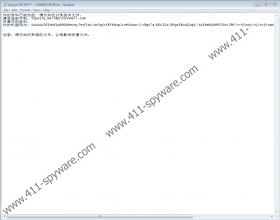Pojie Ransomware Removal Guide
Pojie Ransomware is a dangerous threat that can lock all photos, documents, and other files considered personal. The malware locks such data by encrypting it with a robust encryption algorithm. Consequently, it becomes impossible to open such files. The hackers behind the malware ought to offer their decryption tools, but we should warn you that there is a risk that they could scam you. Therefore, no matter how much you want to get your data back, we advise against dealing with hackers if you do not want to risk losing your money. To learn more about the malicious application, we encourage you to read the rest of this article. In it, we explain how the threat could be spread, how it works, and how to erase it. We recommend checking the instructions located below this article for users who want to learn how they could delete Pojie Ransomware manually.
Pojie Ransomware might travel with malicious email attachments, software installers, and other data coming from unreliable sources. Therefore, when it comes to avoiding ransomware and threats alike, it is vital not to interact with any files or links that come from unreliable sources. However, we advise being cautious, even when it seems like the data is coming from reputable companies. For instance, hackers can come up with email messages that might look legit by using reputable companies' logo images and data alike. Also, cybercriminals can create malicious websites that might look precisely like the homepages of various reputable companies. Thus, we advise being alert all the time as well as taking extra precautions like employing a reliable antimalware tool. Make sure you scan all email attachments and other files that may come from unreliable sources or unknown senders with your chosen security tool.
What happens if Pojie Ransomware gets in? The truth is that you might overlook the malicious application. Such threats usually work silently in the background until they finish encrypting targeted files. As said earlier, this malicious application seems to be programmed to encipher personal files like text documents, archives, and photos. To separate them from the files that do not get encrypted, the malware should append and extension titled .52pojie. Therefore, a document called receipt.pdf ought to become receipt.pdf.52pojie. Next, the malicious application should create a text file containing a message written in Chinese. Our researchers say that it does not ask users to pay a ransom. All it does is say that files can be decrypted and give the Pojie Ransomware’s creator's email address. We believe that users who contact the hackers might be asked to pay a ransom as most ransomware creators ask to pay in exchange for a unique decryption key and a decryptor. The problem is that cybercriminals cannot be trusted as they cannot provide any guarantees, and there are known cases when users got scammed. Thus, if you are asked to pay a ransom, we advise not to do so if you do not want to risk getting scammed.
If you decide you want to erase Pojie Ransomware instead, you have a couple of options. The first one is to delete the files belonging to the malware manually. Such a task could be difficult even if you carefully follow the instructions located below this paragraph. That is because we cannot guarantee that they will work for all users. Therefore, it might be easier to choose the second option, which is scanning your system with a reliable antimalware tool. After the scan, you should be allowed to eliminate Pojie Ransomware by pressing the given deletion button.
Get rid of Pojie Ransomware
- Tap Ctrl+Alt+Delete.
- Pick Task Manager.
- Select the Processes tab.
- Look for a process associated with the malware.
- Select the process and click End Task.
- Leave Task Manager.
- Tap Win+E.
- Go to these locations:
%TEMP%
%USERPROFILE%\Downloads
%USERPROFILE%\Desktop - Find the malicious file that was opened before the system got infected, right-click it, and select Delete.
- Navigate to: %USERPROFILE%\Documents
- Search for a malicious executable file that might have a random name, for example, csrsse.exe, right-click it, and select Delete.
- Close File Explorer.
- Empty Recycle Bin.
- Restart the computer.
Pojie Ransomware Screenshots:


